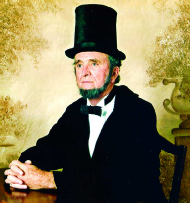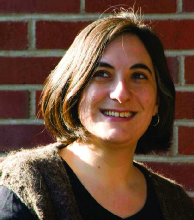John Baylis '71 and Joanne Seiff '95
Emancipation Presentation
John Baylis '71
Like many Americans, John Baylis bought an RV after retirement—but he also bought a handmade replica of a Civil War-era suit and matching stovepipe hat. A veteran Abraham Lincoln impersonator, Baylis spends up to five days a week traveling up and down the East Coast portraying the sixteenth president at elementary schools, battle reenactments, historical societies, and civic groups.
 After earning an undergrad degree in agricultural economics from CALS, Baylis began a forty-three-year career teaching agriculture at his hometown high school near Cassville, New York. At six-foot-four and sporting a full beard, he was often told that he looked like the Great Emancipator. At his first appearance in the early Eighties—his wife suggested he do a presentation to students at the middle school where she taught—he wore a fatigue jacket, jeans, farm boots, and a hat and tie made of posterboard. Eventually, he graduated to a tuxedo and then to tailor-made replica suits, which he isn't ashamed to wear until they're threadbare. "Lincoln would have worn them with holes," he says. Similarly, Baylis takes care to trim his beard unevenly, pointing out that "Lincoln didn't have a good-looking beard."
After earning an undergrad degree in agricultural economics from CALS, Baylis began a forty-three-year career teaching agriculture at his hometown high school near Cassville, New York. At six-foot-four and sporting a full beard, he was often told that he looked like the Great Emancipator. At his first appearance in the early Eighties—his wife suggested he do a presentation to students at the middle school where she taught—he wore a fatigue jacket, jeans, farm boots, and a hat and tie made of posterboard. Eventually, he graduated to a tuxedo and then to tailor-made replica suits, which he isn't ashamed to wear until they're threadbare. "Lincoln would have worn them with holes," he says. Similarly, Baylis takes care to trim his beard unevenly, pointing out that "Lincoln didn't have a good-looking beard."
At events, Baylis is often mobbed by history buffs who want to talk to the former president. When necessary, he has a friend play Lincoln's trusted bodyguard—rushing him off to "an urgent Cabinet meeting" to keep on schedule. In general, though, he loves meeting the public and educating them about slavery, the Civil War, and the president's life. "If people didn't want to talk to Lincoln," he says, "I'd just be traveling around getting dressed up for no reason."
— Mark Fischer '08
Knitting Pretty
Joanne Seiff '95
When Joanne Seiff moved into Risley Hall as a freshman, she was probably the only student toting a spinning wheel. Seiff, who used it to make yarn that she knitted into two dozen pairs of mittens for herself and her friends, was already a knitting veteran when she got to college; she completed her first project at age five, when she began making clothing for her stuffed animals.
 Decades later the former Arts and Sciences double major in comparative literature and Near Eastern studies is still knitting—but instead of dressing dolls, she produces what she calls "wearable art." An expert in handi-crafts such as knitting, weaving, spinning, and sewing, Seiff creates everything from sweaters to rugs. Her work is displayed in galleries and sold throughout the United States and Canada. She has also published two books: Fiber Gathering, which discusses the festivals and traditions associated with fiber art, and Knit Green, which offers tips for environmentally sustainable knitting.
Decades later the former Arts and Sciences double major in comparative literature and Near Eastern studies is still knitting—but instead of dressing dolls, she produces what she calls "wearable art." An expert in handi-crafts such as knitting, weaving, spinning, and sewing, Seiff creates everything from sweaters to rugs. Her work is displayed in galleries and sold throughout the United States and Canada. She has also published two books: Fiber Gathering, which discusses the festivals and traditions associated with fiber art, and Knit Green, which offers tips for environmentally sustainable knitting.
In her books and projects, Seiff aims to optimize the sustainability of fiber art by promoting organic and locally grown materials. "It becomes important to ask, 'Where was this yarn produced?' " she says. "'Where was the wool grown? How far is that from my house?'" In addition to her goal of reducing the carbon footprint of fiber art, Seiff aspires to change the way women's work is viewed. "I like to help people see the skill and intelligence required to produce some of the things that we have taken for granted for thousands of years," Seiff says. "I want them to realize that something made by hand, whether it's bread or yarn, took a great deal of time and talent. People are so used to everything being mass produced that they forget that something made by hand is to be treasured."
— Adrienne Zable '11


